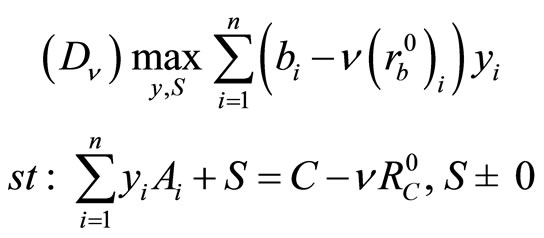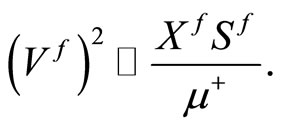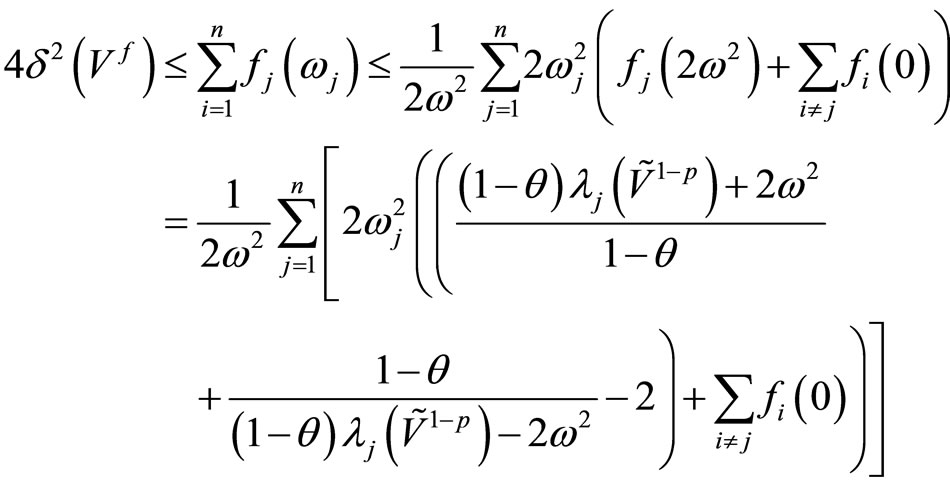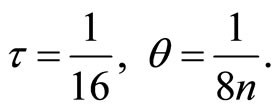A New Full-NT-Step Infeasible Interior-Point Algorithm for SDP Based on a Specific Kernel Function ()
1. Introduction
In this paper we deal with SDP problems, whose primal and dual forms are:

and

where ,
, . The matrices
. The matrices ,
,  are assumed to be linearly independent.
are assumed to be linearly independent.
The use of Interior-Point Methods (IPMs) based on the kernel functions becomes more desirable because of the efficiency from a computational point of view. Many researchers have been attracted by the Primal-Dual IPMs for SDP. For a comprehensive study, the reader is referred to Klerk [1], Roos [2] and Wolkowicz et al. [3]. Bai et al. [4] introduced a new class of so-called eligible kernel functions for Linear Optimization (LO) which are defined by some simple properties following the same way of Peng et al. who have designed a class of IPMs based on a so-called self-regular proximities [5]. These methods use the new search directions which are different than the classic Newton directions. Some extensions were successfully made by Mansouri and Roos [6], Liu and Sun [7]. In the current paper, we propose a new infeasible interior-point algorithm, whose feasibility step is induced by a specific kernel function.
In the sequel, we denotes e as the all one vector and  the vector of eigenvalues of
the vector of eigenvalues of . Two different forms of norm will be used
. Two different forms of norm will be used

2. The Statement of the Algorithm
We start usually with assuming that the initial iterates  and
and  are as follows
are as follows

where I is the  identity matrix,
identity matrix,  is the initial dual gap and
is the initial dual gap and  is such that
is such that

for some optimal solution  of
of  and
and .
.
2.1. The Feasible SDP Problem
The perturbed KKT condition for  and
and  is
is

Based on different symmetrization schemes, several search directions have been proposed.
As in Mansouri and Roos [6], we use in this paper, the so-called NT-direction determined by the following system
 (1)
(1)
where
 (2)
(2)
We also define the square root matrix .
.
The matrix D can be used to rescale X and S to be the same matrix V, defined by
 (3)
(3)
It is clear that D and V are symmetric and positive definite. Let us further define
 (4)
(4)
where . Using the above notations, the third equation of the system (1) is then formulated as follows
. Using the above notations, the third equation of the system (1) is then formulated as follows
 (5)
(5)
It is clear that the first two equations imply that  and
and  are orthogonal, i.e.
are orthogonal, i.e. , which yields that
, which yields that  and
and  are both zero if and only if
are both zero if and only if . In this case, X and S satisfy
. In this case, X and S satisfy , implying that X and S are the
, implying that X and S are the  -centers. Hence, we can use the norm
-centers. Hence, we can use the norm  as a quantity to measure closeness to the
as a quantity to measure closeness to the  -centers. Let us define
-centers. Let us define
 (6)
(6)
2.2. The Perturbed Problem
For any  with
with , we consider the perturbed problem
, we consider the perturbed problem , defined by
, defined by

and its dual problem  given by
given by

where


Note that if  then
then  and
and  , yielding that both
, yielding that both  and
and  are strictly feasible.
are strictly feasible.
Lemma 1 ([6], Lemma 4.1) Let the original problems,  and
and , be feasible. Then for each
, be feasible. Then for each  such that
such that  the perturbed problems
the perturbed problems  and
and  are strictly feasible.
are strictly feasible.
We assume that  and
and  are feasible. It follows from Lemma (1) that the problems
are feasible. It follows from Lemma (1) that the problems  and
and  are strictly feasible. Hence their central path exists. The central path of
are strictly feasible. Hence their central path exists. The central path of  and
and  is defined by the solution sets
is defined by the solution sets  of the following system
of the following system

If  and
and , we denote this unique solution as
, we denote this unique solution as .
.  is the
is the  -center of
-center of , and
, and  the
the  -center of
-center of . By taking
. By taking , one has
, one has  . Initially, one has
. Initially, one has  and
and , whence
, whence  and
and . In what follows, we assume that at the start of each iteration,
. In what follows, we assume that at the start of each iteration,  is smaller than a threshold value
is smaller than a threshold value  which is obviously true at the start of the first iteration. The following system is used to define the step
which is obviously true at the start of the first iteration. The following system is used to define the step 
 (7)
(7)
where  and
and .
.
Inspired by [8], we used in the third equation for the above system, a linearization , which means that we target the
, which means that we target the  -center of
-center of  and
and .
.
After the feasibility step, the new iterates are given by ,
,  and
and . The algorithm begins with an infeasible interior point
. The algorithm begins with an infeasible interior point  such that
such that  is feasible for the perturbed problems,
is feasible for the perturbed problems,  and
and . First we find a new point
. First we find a new point  which is feasible for the perturbed problems with
which is feasible for the perturbed problems with . Then
. Then  is decreased to
is decreased to . A few centering steps are applied to produce new points
. A few centering steps are applied to produce new points  such that
such that . This process is repeated until the algorithm terminates. Starting at the iterates
. This process is repeated until the algorithm terminates. Starting at the iterates  and targeting the
and targeting the  -center, the centering steps are obtained by solving the system (1).
-center, the centering steps are obtained by solving the system (1).
2.3. Infeasible IPMs Based on a Specific Kernel Function
Now we introduce the definition of a kernel function. We call  a kernel function if
a kernel function if  is twice differentiable and the following conditions are satisfied
is twice differentiable and the following conditions are satisfied
1) 
2)  for all
for all 
3) .
.
We define
 (8)
(8)
By using the scaled search directions  and
and  as defined in (4), the system (7) can be reduced to
as defined in (4), the system (7) can be reduced to
 (9)
(9)
According to (8), Equation (9) can be rewritten as
 (10)
(10)
It is clear that the right-hand side of the above equation is the negative gradient direction of the following barrier function  whose kernel logarithmic barrier function is
whose kernel logarithmic barrier function is .
.
Therefore, the aforementioned equation can be rewritten as

Inspired by the work of [4,7,9], and by making a slight modification of the standard Newton direction, the new feasibility step used in this paper, is defined by the following different system:
 (11)
(11)
where the kernel function of  is given by
is given by
 (12)
(12)
Since , the third equation in the system (11) can be rewritten as
, the third equation in the system (11) can be rewritten as
 (13)
(13)
In the sequel, the feasibility step will be based on the Equation (13).
3. Some Technical Results
We recall some interesting results from Klerk [1]. In the sequel, we denote the iterates after a centrality step as ,
,  ,
, .
.
Lemma 2 Let X, S satisfy the Slater’s regularity condition and . If
. If , then the fullNT step is strictly feasible.
, then the fullNT step is strictly feasible.
Corollary 3 Let X, S satisfy the Slater’s regularity condition and . If
. If . One has
. One has .
.
Lemma 4 After a feasible full-NT step the proximity function satisfies

Lemma 5 If , then
, then

The required number of centrality steps can easily be computed. After the  -update, one has
-update, one has  , and hence after k centrality steps the iterates
, and hence after k centrality steps the iterates  satisfy
satisfy

From this, one deduces easily that  holds, after at most
holds, after at most
 (14)
(14)
We give below a more formal description of the algorithm in Figure 1.
The following lemma stated without proof, will be useful for our analysis.
Lemma 6 (See [10], Lemma 2.5) For any , one has
, one has

By applying Lemma (6), one can easily verify so that
for any , we have:
, we have:
 (15)
(15)
and furthermore, according to (6), we obtain:
 (16)
(16)
Lemma 7 According to the result of Corollary (3), for any  one has
one has

Proof. By applying Hölder inequality and using , we obtain
, we obtain

and the result follows.
The following Lemma gives an upper bound for the proximity-measure of the matrix .
.
Lemma 8 Let  be a primal-dual NT pair and
be a primal-dual NT pair and  such that
such that . Moreover let
. Moreover let  and
and . Then
. Then

Proof. Since the  is a primal-dual pair and by applying Lemma (7), and the two inequalities (15) and (16), we can get:
is a primal-dual pair and by applying Lemma (7), and the two inequalities (15) and (16), we can get:

since the last term in the last equality is negative. This completes the proof of the Lemma.
Lemma 9 (See [1], Lemma 6.1). If one has  ,
,  , then
, then , and
, and .
.
Let Q be an  real symmetric matrix and M be an
real symmetric matrix and M be an  real skew-symmetric matrix, we recall the following result.
real skew-symmetric matrix, we recall the following result.
Lemma 10 (See [7], Lemma 3.8). If Q is positive definite, then .
.
Lemma 11 (See [1], Lemma 6.3). If Q is positive definite, then .
.
Lemma 12 (See [7], Lemma 3.10). Let A,  ,
,  and
and . Then
. Then

Lemma 13 (See [11], Lemma A.1) For , let
, let  denote a convex functions. Then, for any nonzero
denote a convex functions. Then, for any nonzero , the following inequality
, the following inequality

holds.
4. Analysis of the Feasibility Step
4.1. The Feasibility Step
As established in Section 2, the feasibility step generates new iterates ,
,  and
and  that satisfy the Feasibility conditions for
that satisfy the Feasibility conditions for  and
and  (i.e., primal feasible and dual feasible), except possibly the positive semidefinite conditions. A crucial element in the analysis is to show that after the feasibility step, the inequality
(i.e., primal feasible and dual feasible), except possibly the positive semidefinite conditions. A crucial element in the analysis is to show that after the feasibility step, the inequality  holds, i.e., that the new iterates are within the region where the Newton process targeting at the
holds, i.e., that the new iterates are within the region where the Newton process targeting at the  -centers of
-centers of  and
and  is quadratically convergent. Let X, y and S denote the iterates at the start of an iteration and assume that
is quadratically convergent. Let X, y and S denote the iterates at the start of an iteration and assume that . Recall that at the start of the first iteration this is true since
. Recall that at the start of the first iteration this is true since . Defining
. Defining  and
and  as in (4) and
as in (4) and  as in (3). We may write
as in (3). We may write

Therefore  which implies that
which implies that
 (17)
(17)
According to (8), Equation (13) can be rewritten as
 (18)
(18)
and by multiplying both side from the left with V, we get
 (19)
(19)
To simplify the notation in the sequel, we denote
 (20)
(20)
Note that  is symmetric and M is skew-symmetric. Now we may write, using (19),
is symmetric and M is skew-symmetric. Now we may write, using (19),

By subtracting and adding , to the last expression we obtain
, to the last expression we obtain

Using (20) and (17), we get
 (21)
(21)
Note that due to (8),  is positive definite.
is positive definite.
Lemma 14 Let  and
and . Then the iterates
. Then the iterates  are strictly feasible if
are strictly feasible if
 .
.
Proof. We begin by introducing a step length , and we define
, and we define

We then have ,
,  and similar relations for y and S. It is clear that
and similar relations for y and S. It is clear that . We want to show that the determinant of
. We want to show that the determinant of  remains positive for all
remains positive for all . We may write
. We may write

By subtracting and adding  and
and
 to the right hand side of the above equality we obtain
to the right hand side of the above equality we obtain

where the matrix

is skew-symmetric for all . Lemma (11) implies that the determinant of
. Lemma (11) implies that the determinant of  will be positive if the symmetric matrix
will be positive if the symmetric matrix

is positive definite which is true for all . This means that
. This means that  has positive determinant. By positiveness of
has positive determinant. By positiveness of  and
and  and continuity of both
and continuity of both  and
and , we deduce that
, we deduce that  and
and  are positive definite which completes the proof.
are positive definite which completes the proof.
We continue this section by recalling the following Lemma.
Lemma 15 (See [12], Lemma II. 60). Let  be as given by (6) and
be as given by (6) and . Then
. Then

The proof of Lemma (15), together with , makes clear that the elements of the vector
, makes clear that the elements of the vector  satisfy
satisfy
 (22)
(22)
Furthermore, by using (8) and (22), we obtain the bounds of the elements of the vector 
 (23)
(23)
In the sequel we denote

where

This implies

and

Lemma 16 Assuming , one has
, one has

Proof. Using (6), we get

where 
From (21), one has

Due to the fact that  since M is skewsymmetric and Lemma (10), we may write
since M is skewsymmetric and Lemma (10), we may write

where we apply for the third equality, Lemma (12) whose second condition is due to the requirement (24) given below.
For each , we define
, we define

It is clear that  is convex in
is convex in  if
if
 . Taking
. Taking , we require
, we require

By applying Lemma (15), the above inequality holds if
 (24)
(24)
By using Lemma (13), we may write

where

Furthermore, by using Lemma (8), we get

We deduce

where

Hence

The last equality is due to (24), which completes the proof.
Because we need to have , it follows from this lemma that it suffices if
, it follows from this lemma that it suffices if
 (25)
(25)
Now we decide to choose
 (26)
(26)
Note that the left-hand side of (25) is monotonically increasing with respect to . By some elementary calculations, for
. By some elementary calculations, for  and
and , we obtain
, we obtain
 (27)
(27)
4.2. Upper Bound for 
In this section we consider the linear space
 .
.
It is clear that the affine space

equals  and
and . We can get from Mansouri and Roos [6], the following result.
. We can get from Mansouri and Roos [6], the following result.
Lemma 17 (See [6], Lemma 5.11) Let Q be the (unique) matrix in the intersection of the affine spaces  and
and . Then
. Then

Note that (27) implies that we must have  to guarantee
to guarantee . Due to the above lemma, this will certainly hold if
. Due to the above lemma, this will certainly hold if  satisfies
satisfies
 (28)
(28)
Furthermore, according to Mansouri and Ross, we have

Since , we may write
, we may write

By using , the above inequality becomes
, the above inequality becomes
 (29)
(29)
Because we are looking for the value that we do not allow  to exceed and in order to guarantee that
to exceed and in order to guarantee that  , (28) holds if
, (28) holds if  satisfies
satisfies
 , since
, since . This will be certainly satisfied if
. This will be certainly satisfied if . Hence, combining this with (29), we deduce that
. Hence, combining this with (29), we deduce that  holds.
holds.
4.3. Iteration Bound
In the previous sections, we have found that, if at the start of an iteration the iterates satisfies , with
, with , then after the feasibility step, with
, then after the feasibility step, with  as defined in (26), the iterates satisfies
as defined in (26), the iterates satisfies . According to (14), at most
. According to (14), at most  centering steps suffice to get iterates that satisfy
centering steps suffice to get iterates that satisfy . So each main iteration consists of at most 3 so-called inner iterations. In each main iteration both the duality gap and the norms of the residual vectors are reduced by the factor
. So each main iteration consists of at most 3 so-called inner iterations. In each main iteration both the duality gap and the norms of the residual vectors are reduced by the factor . Hence, using
. Hence, using , the total number of main iterations is bounded above by
, the total number of main iterations is bounded above by

Since , the total number of inner iterations is so bounded above by
, the total number of inner iterations is so bounded above by

5. Concluding Remarks
In this paper we extended the full-Newton step infeasible interior-point algorithm to SDP. We used a specific kernel function to induce the feasibility step and we analyzed the algorithm based on this kernel function. The iteration bound coincides with the currently best known bound for IIPMs. Future research might focuses on studying new kernel functions.
6. Acknowledgements
The authors gratefully acknowledge the help of the guest editor and anonymous referees in improving the readability of the paper.